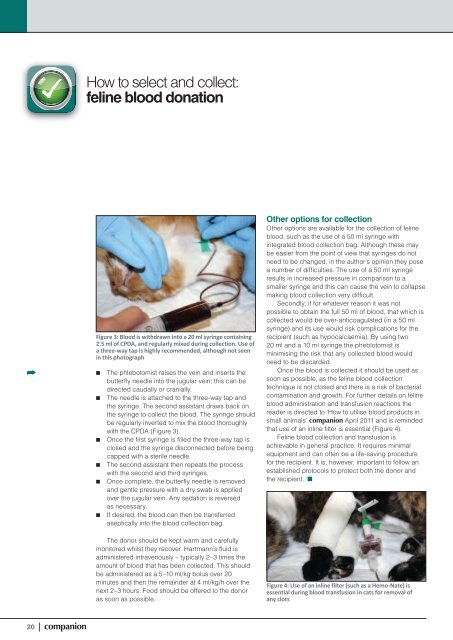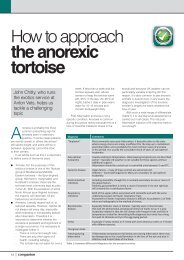Companion May 2012 - BSAVA
Companion May 2012 - BSAVA
Companion May 2012 - BSAVA
You also want an ePaper? Increase the reach of your titles
YUMPU automatically turns print PDFs into web optimized ePapers that Google loves.
20 | companion<br />
How to select and collect:<br />
feline blood donation<br />
Figure 3: Blood is withdrawn into a 20 ml syringe containing<br />
2.5 ml of cpDA, and regularly mixed during collection. Use of<br />
a three-way tap is highly recommended, although not seen<br />
in this photograph<br />
■■ The phlebotomist raises the vein and inserts the<br />
butterfly needle into the jugular vein; this can be<br />
directed caudally or cranially.<br />
■■ The needle is attached to the three-way tap and<br />
the syringe. The second assistant draws back on<br />
the syringe to collect the blood. The syringe should<br />
be regularly inverted to mix the blood thoroughly<br />
with the CPDA (Figure 3).<br />
■■ Once the first syringe is filled the three-way tap is<br />
closed and the syringe disconnected before being<br />
capped with a sterile needle.<br />
■■ The second assistant then repeats the process<br />
with the second and third syringes.<br />
■■ Once complete, the butterfly needle is removed<br />
and gentle pressure with a dry swab is applied<br />
over the jugular vein. Any sedation is reversed<br />
as necessary.<br />
■■ If desired, the blood can then be transferred<br />
aseptically into the blood collection bag.<br />
The donor should be kept warm and carefully<br />
monitored whilst they recover. Hartmann’s fluid is<br />
administered intravenously – typically 2–3 times the<br />
amount of blood that has been collected. This should<br />
be administered as a 5–10 ml/kg bolus over 20<br />
minutes and then the remainder at 4 ml/kg/h over the<br />
next 2–3 hours. Food should be offered to the donor<br />
as soon as possible.<br />
Other options for collection<br />
Other options are available for the collection of feline<br />
blood, such as the use of a 50 ml syringe with<br />
integrated blood collection bag. Although these may<br />
be easier from the point of view that syringes do not<br />
need to be changed, in the author’s opinion they pose<br />
a number of difficulties. The use of a 50 ml syringe<br />
results in increased pressure in comparison to a<br />
smaller syringe and this can cause the vein to collapse<br />
making blood collection very difficult.<br />
Secondly, if for whatever reason it was not<br />
possible to obtain the full 50 ml of blood, that which is<br />
collected would be over-anticoagulated (in a 50 ml<br />
syringe) and its use would risk complications for the<br />
recipient (such as hypocalcaemia). By using two<br />
20 ml and a 10 ml syringe the pheblotomist is<br />
minimising the risk that any collected blood would<br />
need to be discarded.<br />
Once the blood is collected it should be used as<br />
soon as possible, as the feline blood collection<br />
technique is not closed and there is a risk of bacterial<br />
contamination and growth. For further details on feline<br />
blood administration and transfusion reactions the<br />
reader is directed to ‘How to utilise blood products in<br />
small animals’ companion April 2011 and is reminded<br />
that use of an inline filter is essential (Figure 4).<br />
Feline blood collection and transfusion is<br />
achievable in general practice. It requires minimal<br />
equipment and can often be a life-saving procedure<br />
for the recipient. It is, however, important to follow an<br />
established protocols to protect both the donor and<br />
the recipient. ■<br />
Figure 4: Use of an inline filter (such as a hemo-Nate) is<br />
essential during blood transfusion in cats for removal of<br />
any clots



